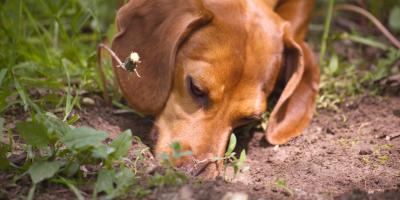How to Trim Dog Nails: Step-By-Step


Keeping your dog’s nails trimmed is an essential part of dog ownership. Many dog parents take care of this themselves, while others take their dogs to the groomer for a puppy mani-pedi. If you’d like tips on how to cut your dog’s nails, this article provides step-by-step instructions and answers frequently asked questions about dog nail trimming.
How Often Should You Trim Your Dog’s Nails?
How often you should trim your dog’s nails depends on your dog. Most professionals recommend clipping a dog’s nails every two weeks for short nails, and at least once a month for normal length nails.
What is the easiest way to trim dog nails? The easiest way is to have a groomer do it for you. But getting that done once a month—or more often if needed—can add up, so learning to do it yourself is best. Learning how to clip your dog’s nails is part of the routine care you should provide your pet.
Dog owners who walk their dogs regularly on pavement or concrete may be able to keep their dog’s nails short without clipping, or at least lengthen the time between nail trimmings. The rough surface of the pavement works as a nail file that naturally keeps your dog’s nails trimmed. Just be careful when walking your dog on concrete in extreme temperatures, as excessively hot or cold pavement can be uncomfortable for your dog’s paw pads.
Keep in mind that walking on concrete only files the nails that touch the pavement. The dewclaws on dogs—the claws on the upper, inner part of the dog’s front feet—still need to be trimmed manually.
It’s important to keep your dog’s nails trimmed, whether it happens naturally, you do it yourself, or you take him to a groomer. Long nails force your dog’s foot to splay out and stand awkwardly, and if left untrimmed for an extended period time, can cause other problems, such as:
- Pain
- Ingrown nails on your dog’s foot pad
- Deformed feet
- Injured tendons
- Broken nails or split nails
- Potential joint issues as your dog ages
Your dog’s long nails will scratch the finish on your hardwood floors, reduce your dog’s traction on slick surfaces, and may get caught on carpets, blankets, and collars.
How Do You Know When a Dog’s Nails Are Too Long?
When you hear your dog’s nails tapping on hard surfaces as he walks, you know your dog’s nails are too long and it’s time for a trim.
A dog’s nail consists of living pink tissue, called the quick, and a hard outer material or shell. A dog’s nail quick includes nerves and blood vessels that supply blood to the tissue. If the quick is cut, it is painful, and your dog’s nail will start bleeding.
How far do you clip a dog’s nails? You want to trim the nail enough but avoid the quick. For dogs with light nails, the quick is easy to see and avoid. It’s more difficult to identify on dark or black nails. To clip black dog nails, look for a groove on the underside of the nail that separates the hard nail from the soft cuticle. You can also hold a flashlight up to the black nail to see where the quick starts. Another option is to look at the nail tip, and if you see a small dark center circle on the grey, that is the quick. If that small dark circle is visible, don’t trim the nail or you’ll hit the quick.
How should you cut overgrown dog nails? If your dog’s nails are overgrown, you might want to get the first trim done by a vet or a groomer. With regular trimming, the quick will recede from the end of the nail. Then it will be easier to trim your dog’s nails at home without cutting the quick.
Preparing to Trim Your Dog’s Nails
Can you clip dog nails with human clippers? No, you should only use clippers specifically designed as dog nail trimming tools. If you’ve never trimmed your dog’s nails before, ask your vet or groomer to show you how and recommend the best clippers for your dog. There are several clipper options, including guillotine style, which have a hole you push the nail through; scissors style, which are best for small dogs and puppies; and pliers style, which have a spring making them stronger for large, thick nails.
You may also choose to trim nails with a dog nail grinder, but many of these devices can be loud and that noise might frighten your dog. Also, nail grinders usually take longer to get the job done, so it may not be the best option for dogs that are easily restless. The top benefits of using nail grinders are that they make it easier to avoid the quick, and the trimmed nail is filed smoothly.
If your dog is still a puppy, it’s a good idea to get him used to the clippers or the grinder at an early age. It will make trimming his nails as an adult dog much easier and less stressful.
How do you clip a dog’s nails that hates it? For adult dogs that are not used to getting their nails trimmed or just hate the procedure, you might want to spend several days gradually introducing your dog to the clippers or grinder. This process also works for puppies:
- Step 1: Begin by letting your dog sniff the trimmer or grinder and then put it away. Give your dog lots of treats and pets. Repeat this trial several times over a couple of days.
- Step 2: Just touch the clippers or grinder to your dog’s paw. Again, give your dog lots of treats and pets and repeat until you are sure your dog is ready to move to the next step.
- Step 3: Squeeze the clippers or turn on the grinder near your dog’s paw so he learns the sound. Give more treats and pets. Repeat as necessary over a couple of days.
- Step 4: Try trimming the tiniest tip from one nail, giving encouragement and treats after each clip. If it seems like your dog is getting overly nervous after the first clip, start over the next day with the Step 2 trial. If he’s calm, trim the one nail, and reward him with treats and pets.
- Day 5 – whenever: Trim a tiny bit from one nail every day until he doesn’t seem to mind. Keep trimming one or two nails daily. Give your dog lots of treats and pets after every session. Add another nail each day and, after a few weeks, you should be able to do the full set in one session.
Whenever you trim a dog’s nails, there is a chance you’ll hit the quick (see below). If you have introduced the process gradually with lots of positive reinforcement, as instructed above, that will make a stronger impression than the negative event of cutting the quick. Your dog will have all these positive experiences to counter the one bad experience, and he is less likely to regress into being fearful of nail trims.
Supplies You’ll Need to Clip Dog Nails
Before you begin, make sure you have the right supplies. You’ll need:
- The right clippers for your dog
- Cotton balls or clean cloth
- Styptic powder – a clotting agent in case you hit the quick
- Dog treats
Can you restrain your dog for nail clipping? A second person can help hold your dog steady. Some people like to use a dog grooming harness that holds your dog still and leaves their nails exposed.
How to Trim a Dog’s Nails, Step-By-Step
What’s the best way to clip your dog’s nails? Here is a step-by-step guide:
- Step 1: Get down on the floor to avoid twisting your dog’s foot too much.
- Step 2: Pick your dog’s paw up firmly, but gently, and look at the underneath of the nail to see the quick. Place your thumb on the pad of the toe and your forefinger on the top of the toe, on the skin above the nail. Make sure none of your dog’s fur is in the way.
- Step 3: Push your thumb back slightly while pushing your forefinger forward to extend the nail.
- Step 4: Place the clippers at the very edge of the nail if you do not see a quick.
- Step 5: Hold the clippers at a 45-degree angle.
- Step 6: Clip only the tip of the nail at a time. Stop. Review before continuing. Avoid clipping past the curve of the nail, or you risk hitting the quick.
- Step 7: Hold his paw and nail up to the light and look at the center of the nail. Check for the quick, which looks like a dark inner circle at the center of the nail.
- Step 8: Finish all the nails that need trimming, including the dewclaws on the back of your dog’s front legs.
- Step 9: Give your dog plenty of treats and praise throughout the process.
How to Stop a Dog’s Nail From Bleeding
If you accidentally cut the quick, and your dog’s nail starts to bleed, don’t panic. Pour some of the styptic powder directly on the wound to help with clotting and ease the pain. Cover with a cotton ball or bandage and apply pressure to the tip of the nail. The bleeding should stop within a few minutes. If it doesn’t stop, reapply the powder and pressure. After that, if the nail is still bleeding, call your vet.
Keep your dog calm and quiet so that the nail is not further damaged or injured with walking or running. How long does it take a dog nail that’s cut too short to heal? Depending on the injury, it can take up to two weeks for the nail to grow long enough to protect the quick.
The wound should stay bandaged to keep it clean and to prevent your dog from licking it. There is a risk of infection from the environment or the bacteria in your dog’s mouth if the wound is not properly bandaged. Call your veterinarian if you notice any signs of swelling, pain, or discomfort as these can be signs that the nail has become infected.
The more you practice, the more comfortable and experienced you and your dog will get when it comes to trimming nails.
For more expert tips on grooming your dog, explore our other dog routine care articles.
Related articles

Reward Yourself with myPurina
Earn and redeem rewards for Purina products with the myPurina app.






